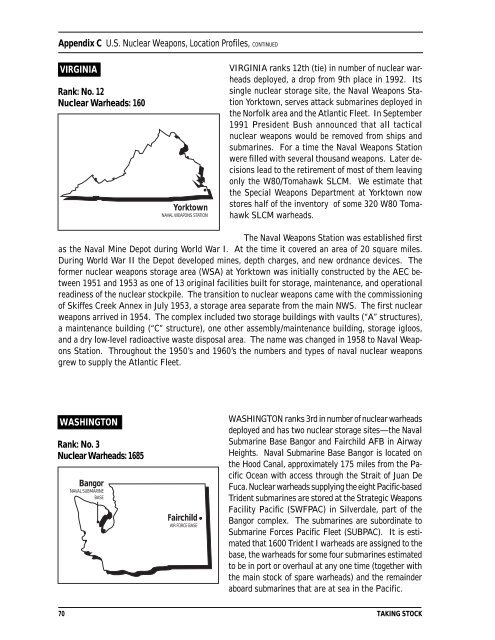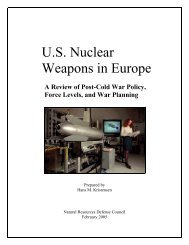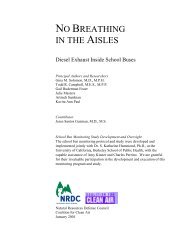p.53-94 (pdf) - Natural Resources Defense Council
p.53-94 (pdf) - Natural Resources Defense Council
p.53-94 (pdf) - Natural Resources Defense Council
You also want an ePaper? Increase the reach of your titles
YUMPU automatically turns print PDFs into web optimized ePapers that Google loves.
Appendix C U.S. Nuclear Weapons, Location Profiles, CONTINUED<br />
VIRGINIA<br />
Rank: No. 12<br />
Nuclear Warheads: 160<br />
WASHINGTON<br />
Rank: No. 3<br />
Nuclear Warheads: 1685<br />
Bangor<br />
NAVAL SUBMARINE<br />
BASE<br />
Yorktown<br />
NAVAL WEAPONS STATION<br />
Fairchild<br />
AIR FORCE BASE<br />
VIRGINIA ranks 12th (tie) in number of nuclear warheads<br />
deployed, a drop from 9th place in 1992. Its<br />
single nuclear storage site, the Naval Weapons Station<br />
Yorktown, serves attack submarines deployed in<br />
the Norfolk area and the Atlantic Fleet. In September<br />
1991 President Bush announced that all tactical<br />
nuclear weapons would be removed from ships and<br />
submarines. For a time the Naval Weapons Station<br />
were filled with several thousand weapons. Later decisions<br />
lead to the retirement of most of them leaving<br />
only the W80/Tomahawk SLCM. We estimate that<br />
the Special Weapons Department at Yorktown now<br />
stores half of the inventory of some 320 W80 Tomahawk<br />
SLCM warheads.<br />
The Naval Weapons Station was established first<br />
as the Naval Mine Depot during World War I. At the time it covered an area of 20 square miles.<br />
During World War II the Depot developed mines, depth charges, and new ordnance devices. The<br />
former nuclear weapons storage area (WSA) at Yorktown was initially constructed by the AEC between<br />
1951 and 1953 as one of 13 original facilities built for storage, maintenance, and operational<br />
readiness of the nuclear stockpile. The transition to nuclear weapons came with the commissioning<br />
of Skiffes Creek Annex in July 1953, a storage area separate from the main NWS. The first nuclear<br />
weapons arrived in 1954. The complex included two storage buildings with vaults (“A” structures),<br />
a maintenance building (“C” structure), one other assembly/maintenance building, storage igloos,<br />
and a dry low-level radioactive waste disposal area. The name was changed in 1958 to Naval Weapons<br />
Station. Throughout the 1950’s and 1960’s the numbers and types of naval nuclear weapons<br />
grew to supply the Atlantic Fleet.<br />
WASHINGTON ranks 3rd in number of nuclear warheads<br />
deployed and has two nuclear storage sites—the Naval<br />
Submarine Base Bangor and Fairchild AFB in Airway<br />
Heights. Naval Submarine Base Bangor is located on<br />
the Hood Canal, approximately 175 miles from the Pacific<br />
Ocean with access through the Strait of Juan De<br />
Fuca. Nuclear warheads supplying the eight Pacific-based<br />
Trident submarines are stored at the Strategic Weapons<br />
Facility Pacific (SWFPAC) in Silverdale, part of the<br />
Bangor complex. The submarines are subordinate to<br />
Submarine Forces Pacific Fleet (SUBPAC). It is estimated<br />
that 1600 Trident I warheads are assigned to the<br />
base, the warheads for some four submarines estimated<br />
to be in port or overhaul at any one time (together with<br />
the main stock of spare warheads) and the remainder<br />
aboard submarines that are at sea in the Pacific.<br />
70 TAKING STOCK
















